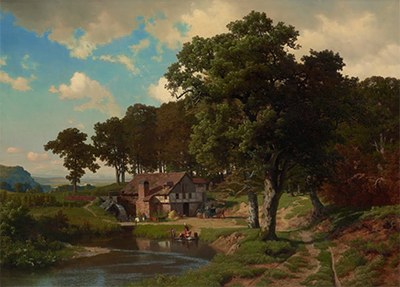Bierstadt was the most prominent painter of the Western expansion themes throughout the nineteenth century, although not the first to document them. The 1855 painting by Albert Bierstadt A Rustic Mill represents the luxuriant, lush, and extravagant scenes that attracted many informal art purchasers in late-nineteenth-century America, all of which were described in enormous sizes.
Bierstadt's role as a documentarian of the American West, accompanying explorers on the Westward Expansion, has been entrenched in the American national heritage. The artist's representations of spectacular sceneries and meandering landscapes rendered him as one of the leading players of the Hudson River School, an eclectic gathering of artists, in several cases the very first white European to depict such landscapes.
Consequently, the theme depicted in A Rustic Mill is ecstatic. The rustic mill has a charming aesthetic, a bizarre intrigue, and a delightful charisma. Beside it, there are romantic themes. Triumphant and joyful memories surround it. With its rural, rustic landscape, the old mill is ancient in origin and distinctive in design, and it maintains a special place in human memory. The old rustic mill is now undeniably unrivaled in terms of Romanticism and charm. It conveys an ideal past by being both historic and glamorous. The artwork was first painted in the United States and is currently located at The Audrey Jones Beck Building, 108 Hevrdejs Gallery.
Elsewhere, the Hudson River School was noted for a distinctive style marked by bright lighting, aerial viewpoint, imperceptible painting, and serene, rural views, which would eventually be recognized as Luminism, influenced by Romanticism's distinctive features properties. Though it predates Modernism, Luminism has nothing to do with the French aesthetic style of portraying the light effects; instead, Bierstadt and his colleagues were drawn to representing things like they should be and not as they exist.
Bierstadt was traveling about Europe in the mid-1850s, researching, educating, and relishing in the range of gorgeous views available in Germany as well as the Alps. For the remainder of his life, the mountainous region influenced the designer's artistic perception, and A Rustic Mill was perhaps created around this era. The author's ability to weave a faraway Eden off an agrarian reality may be seen in this painting, which dates to before Bierstadt gained fame as the utopian speaker of the Western Expansion. However, Bierstadt's success relied on his abilities as a performer and an entrepreneur, who capitalized on the prevalent atmosphere of the period and the emotions found in literature, poetry, and artwork. As a result, Bierstadt's canvases have a certain romanticism to them, culminating in projected copies of the Western United States that would draw a swarm of off-the-beaten-path pioneers.




